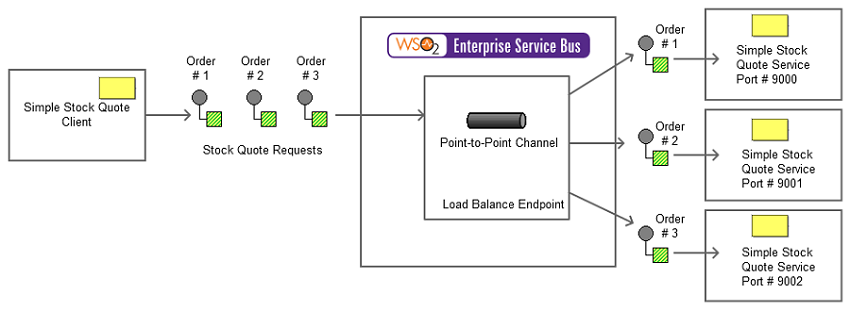This section explains, through an example scenario, how the Point-to-Point Channel EIP can be implemented using the WSO2 ESB. The following topics are covered:
Introduction to Point-to-Point Channel
The Point-to-Point Channel EIP pattern ensures that only a single receiver consumes a message (when there are multiple receivers waiting to consume the message). For more information, see Point to Point Channel.
Figure 1: Point-to-Point Channel EIP
Example scenario
The example scenario uses an inventory of stocks. It illustrates how a stock quote is generated, which only a single consumer receives at a given time. The diagram below depicts how this example is simulated using the ESB.
Figure 2: Example scenario of the Point-to-Point Channel EIP
Before digging into implementation details, let's take a look at the relationship between the example scenario and the Point-to-Point Channel EIP by comparing their core components.
| Point-to-Point EIP (Figure 1) | Point-to-Point Channel Example Scenario (Figure 2) |
|---|---|
Sender | Stock Quote Client |
Order | Stock Quote Requests |
Point to Point Channel | Load-balance Endpoint |
| Receiver | Three instances of the Stock Quote service |
The ESB configuration
Given below is the ESB configuration for simulating the example scenario explained above.
<definitions xmlns="http://ws.apache.org/ns/synapse">
<proxy xmlns="http://ws.apache.org/ns/synapse" name="PointToPointProxy" transports="http https" startOnLoad="true" >
<target>
<inSequence>
<send>
<endpoint>
<!-- Channel With Multiple Endpoints Load Balancer Will Ensure that only one will receive it -->
<loadbalance>
<endpoint>
<address uri="http://localhost:9000/services/SimpleStockQuoteService/" />
</endpoint>
<endpoint>
<address uri="http://localhost:9001/services/SimpleStockQuoteService/" />
</endpoint>
<endpoint>
<address uri="http://localhost:9002/services/SimpleStockQuoteService/" />
</endpoint>
</loadbalance>
</endpoint>
</send>
</inSequence>
<outSequence>
<respond/>
</outSequence>
</target>
</proxy>
</definitions>
The configuration elements
The elements used in the above ESB configuration are explained below.
- <proxy> - This is the proxy service that should be invoked to execute the configuration.
- <inSequence> - A message is first received by the proxy service, and then directed to this sequence.
- <outSequence> - This sequence is triggered after the execution of the <inSequence>.
- <send> - When a matching case is found, the Send mediator routes the message to the endpoint indicated by the address URI.
- <load balance> - Manages the array of services defined within this endpoint. It streams the request only to one instance, which is selected using the given algorithm.
- <outSequence> - Receives the response from an endpoint and sends the response back to the client.
Simulating the example scenario
Now, let's try out the example scenario explained above.
Setting up the environment
You need to set up the ESB, and the back-end service:
- Download the
Point-To-Point_1.0.0.zipfile, which includes the ESB configuration described above. - See Setting up the Environment for instructions on setting up the ESB and the back-end service.
Executing the sample
Let's send a request to the ESB using the Stock Quote Client application. Find out more about the Stock Quote Client from the ESB documentation.
- Open a new terminal, and navigate to the
<ESB_HOME>/samples/axis2Client/directory. The Stock Quote client application is stored in this directory. Execute the following command to send the request to the ESB.
ant stockquote -Dtrpurl=http://localhost:8280/services/point-to-point-proxy -Dsymbol=foo
The structure of the request should be as follows:
<soapenv:Envelope xmlns:soapenv="http://schemas.xmlsoap.org/soap/envelope/" xmlns:ser="http://services.samples" xmlns:xsd="http://services.samples/xsd"> <soapenv:Header /> <soapenv:Body> <ser:getQuote> <ser:request> <ser:symbol>foo</ser:symbol> </ser:request> </ser:getQuote> </soapenv:Body> </soapenv:Envelope>
Analyzing the output
Note that, out of all three instances of the Stock Quote service (Axis2 server), only one server acquires the sent request at a given time.
Stock client response:
Standard :: Stock price = $81.06211284751495
samples.services.SimpleStockQuoteService :: Generating quote for : foo
If you try sending multiple requests, you will notice in the Console logs of each of the Axis2 server instances that the three of them are receiving the message one after another (i.e., in Round Robin pattern).

